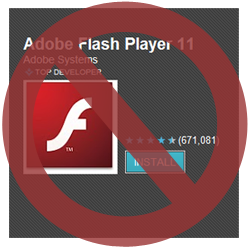The bell tolled on August 15 for Android-based device owners using Adobe’s Flash Player multimedia plugin. As foretold in November 2011, Adobe will be offering no certified implementations of Adobe’s Flash Player beyond Android OS 4.1, and as of August 15, Flash has been removed from Google’s app store, Play, according to a PCWorld article,
Despite the ever-present hullabaloo over the crowned-prince of all multimedia plugins, Adobe ultimately sided with critics such as Apple, Inc. and Microsoft who have long had concerns that the resource-hungry plugin was just too much for any mobile platform. Consequently, Apple iOS users have always been Flash free. Conversely, device makers have at times used the availability of Flash on Android devices as a selling point. Now that the playing field has been evened up, many users may be wondering what all the fuss was about:
What is so wrong with Flash?
Adobe axed the Flash Player on mobile devices for a number of reasons, the prolific nature of Flash content across the Internet notwithstanding. First and foremost, the Flash technology was intended to be used in a desktop, or laptop, environment with traditional input devices, such as a keyboard and mouse. In fact, many of the functions in Flash code depend on mouse rollover actions that cannot be mimicked in a touch-screen environment. Another reason Flash is not a good fit for the mobile platform is battery life. The plugin is quite resource intensive, and any smart phone, or tablet, users who do a lot of web surfing of Flash-enabled websites will experience shorter than expected battery life on their devices. Security is another issue. Malicious code can be exploited through unpatched versions of Flash Player leading to the potential risk of identity theft and other privacy issues. These are just a few outlined in another PCWorld article.
We’re better off without Flash. Or are we?
With the advent of HTML5, the next iteration of the hypertext markup language that provides the skeletal framework for most web pages, the ability to display multimedia content, such as audio, video and other interactive elements is built into the framework of the HTML5 language. To insert a video, developers need only to insert a video tags:
<video width=”320″ height=”240″ controls=”controls”>
<source src=”movie.mp4″ type=”video/mp4″ /></video>
So, HTML5 fixes everything, right? Not exactly. HTML5 still only works on the most updated of all web browsers – regardless of platform. Unfortunately, much of the Internet’s users still use outdated web browsers, such as Internet Explorer 6, or older smart phones, and will not be able to view HTML5-coded web pages from their devices.
How will this affect users?
The absence of Flash for Android users will be marginally noticeable at best, thanks to an accelerated adoption of HTML5 over the last five years by developers, due in no small part to Apple’s refusal to accommodate Flash on its mobile devices and followed by Microsoft with its Windows Phone platform. For example, most YouTube content will play in either Flash or as H.264 videos in HTML5. Additionally, most developers build non-Flash versions of websites for accessibility reasons and to accommodate iOS devices. Any proprietary video content developed entirely in Adobe Flash will not work on Android devices without the Flash Player until the content is ported for HTML5 compatibility.
Can’t live without Flash?
All is not lost; however, at least not for those willing to go the extra mile to install Flash. Even though Flash is gone from the Google Play Store, according to a PCWorld article, Flash can still be installed by downloading an archived package from Adobe’s website and sideloading it to a service such as APKinstall. Keep in mind that this is a developer process and not for the feint of heart.
Conclusions
Despite Adobe’s abandonment of the Flash Player plugin for mobile platforms, the Internet shall endure. Plugins such as Adobe’s Flash Player, Microsoft’s SilverLight and Apple’s Quicktime are all third-party components that enable the integration of content on webpages, but the content is what matters. It seems that Adobe, at the detriment of one of its flagship products, has decided that Flash may not be the best tool for the job.
Timeline
- Jan. 9, 2007 – Apple launches iPhone with no Flash Player available
- April 2010 – Open letter from Steve Jobs on why there will be no Flash on iPhone
- Now. 2011 – Adobe announces that it is stopping new development of Flash Player for mobile devices
- June 2012 – Adobe announces it will not support Flash Player on Android 4.1 and above
- August 15, 2012 – Adobe pulls Flash Player from the Play store, blocks new installs
- September 2013 – Adobe will no long provide security updates for Flash Player on Android
How will the lack of Flash Player on Android devices affect you? Let us know in the comments:

Recent Comments